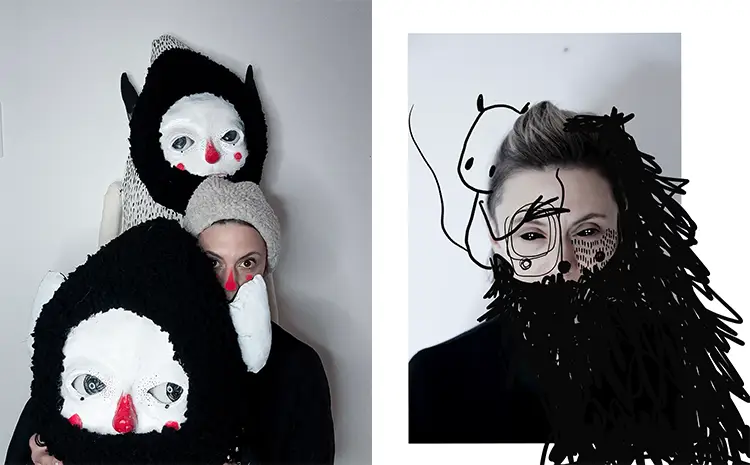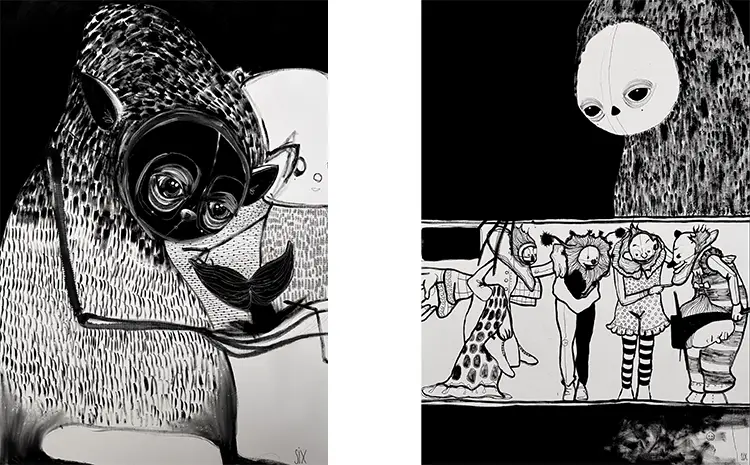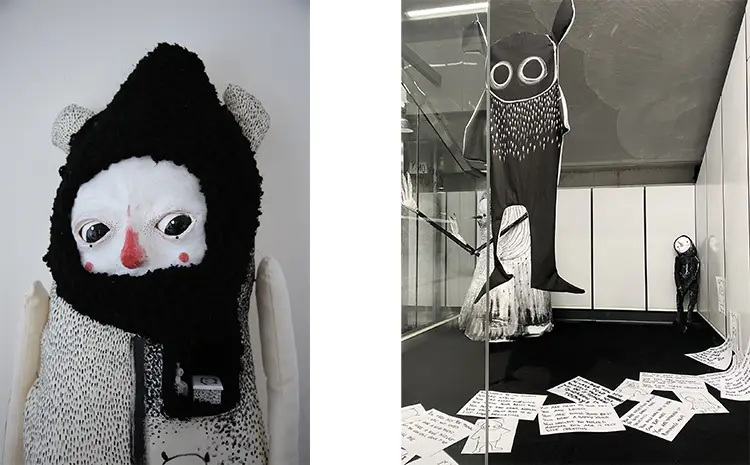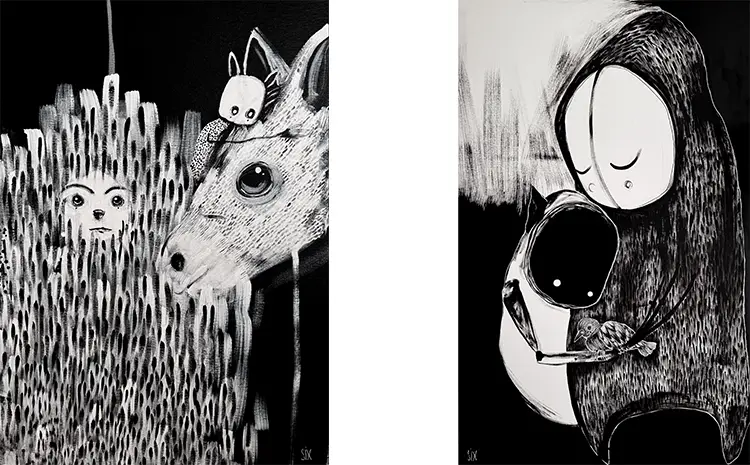“My creatures seem to appear in everything—for me they are some sort of extension of my inner states, emissaries from hidden worlds.”
The Art of Communicating with the Unseen
Claudia Six stands at the intersection of performance, character design, and installation art, weaving together disciplines into an artistic language that feels both intimate and expansive. A mixed media artist whose creations inhabit a monochrome world of black and white, Six invites viewers into immersive spaces where dream logic takes precedence over linear narrative. Her work is shaped by an insatiable curiosity about consciousness, perception, and the unseen dimensions of experience—questions that animate her creatures and installations, turning them into emissaries of hidden psychological landscapes. With influences spanning from theater and film studies to fashion design and contemporary character creation, her multifaceted background fosters a practice that defies easy categorization while consistently seeking connection through vulnerability and storytelling.
Rather than adhering to a single medium, Six’s practice flows between sculpture, textiles, puppetry, video, and drawing. Her signature creations—strange yet familiar creatures—emerge across these formats, acting as vessels for inner dialogues and unspoken fears. These beings are not merely aesthetic objects but living participants within her narratives, bridging the gap between the artist’s internal explorations and the audience’s subconscious reflections. This fluidity of mediums supports her belief that no material alone can fully express the complex territories of human emotion and perception. Instead, she allows her choice of medium to be dictated by the message, making space for an organic development of each piece.
Fueling her creative universe is a fascination with physics and psychology, fields in which she holds no formal degree but which deeply inform her artistic inquiries. Concepts such as spacetime, string theory, consciousness, and the nuances of communication between all living entities subtly echo through her work. These themes underscore her desire to understand what exists between the tangible and the intangible—the spaces where fear takes root, where dreams collide with reality, and where nonverbal messages go unnoticed but persist nonetheless. This ongoing pursuit shapes not only her individual artworks but also the immersive environments she creates, designed to awaken attention to the unseen.

Claudia Six: Inner Worlds, Outer Creatures
Six’s journey as an artist began not with a singular defining moment but as a continuous unfolding of creative instincts fostered since childhood. Long before labeling herself an artist, she engaged deeply with drawing, sculpting, writing, and questioning—the essential practices that would later become the backbone of her career. From an early age, she found herself captivated by the small and easily overlooked aspects of life: insects, neglected objects, and unnoticed details that others might dismiss. This attention to the marginal and the misunderstood sparked her sense of empathy not only toward living creatures but even toward inanimate objects, attributing consciousness to forms conventionally seen as lifeless. This worldview became the seed from which her puppetry and creature-making would eventually grow.
Her early professional steps involved working within the theater world, where she designed and performed for various productions. This phase allowed her to experiment with stop motion animation and puppet creation—mediums that resonated with her fascination for breathing life into otherwise static forms. Gradually, these creatures began to assert themselves not just as props but as central characters, embodying the core emotions and ideas she sought to explore. It became apparent that her practice was less about traditional storytelling and more about constructing thresholds into emotional and psychological spaces—portals through which both the artist and the audience might traverse internal terrains.
This evolution marked a significant shift in how Six approached her art, recognizing that her puppets and installations were not passive displays but interactive zones of exchange. Each creation became a point of contact between artist, object, and viewer, where the act of looking or participating could stir deeply personal reflections. Through these experiences, Six found a unique mode of storytelling—one that did not rely on explicit narrative arcs but instead operated through mood, gesture, and symbolic resonance. Her work asks viewers not simply to observe but to feel, to engage with their own fears, dreams, and inner dialogues through the invitation of her surreal companions.

Fear as a Bridge to Connection
Central to Six’s artistic philosophy is the exploration of fear—not as a paralyzing force, but as a shared human experience capable of fostering connection. Nowhere is this more powerfully embodied than in her installation piece With Fear, a work that holds special significance within her body of art. This installation was conceived as an interactive space where visitors were invited to confront their fears directly by writing them down and placing them at an altar. In exchange, they could take home a small guardian creature, a tangible symbol of care and protection. Each week, Six performed a quiet ritual, burning the collected fears as an act of collective release and transformation.
The emotional core of With Fear lies in its recognition of the commonality of human anxieties. Six observed that despite the uniqueness of individual stories, many fears echo across different lives in surprisingly similar ways. Whether rooted in abandonment, failure, loss, or existential dread, these fears reveal shared vulnerabilities that transcend personal circumstance. By externalizing these emotions and engaging in ritualized acknowledgment, the installation fostered a sense of solidarity among participants. Rather than isolating viewers within their personal struggles, With Fear invited them into a communal space of empathy and healing.
This work exemplifies Six’s broader approach to art-making: creating spaces where vulnerability becomes a point of entry rather than a barrier. Her creatures, often born from the dark corners of imagination, serve as both mirrors and mediators. They embody fears and protectors at once, holding the complexity of emotional life without reducing it to simple dichotomies. Through these installations, Six challenges traditional perceptions of fear, proposing instead that confronting and sharing these emotions can transform isolation into connection—a philosophy that permeates her entire creative practice.

Claudia Six: Crafting Dimensional Experiences
At the heart of Six’s creative process is a deliberate attention to space—both physical and mental. Her studio reflects this intention, structured into distinct zones designed for different stages of her artistic workflow. One area is dedicated to digital work, while other stations support drawing, sewing, painting, and sculptural tasks. Although her sewing and sculpting share a workspace—an admittedly imperfect arrangement—the organization allows her to maintain focus across a diverse set of mediums. Tucked away at the back of her studio, a separate corner for large-scale painting offers the freedom to engage with canvas on a more expansive level. Just outside, a small garden provides a vital sanctuary for reflection and breath between intense periods of creation.
Despite her structured environment, Six acknowledges that managing distractions remains an ongoing challenge. Her solution lies not in multitasking but in creating strong boundaries around her time and attention. She approaches her workdays with discipline, preferring predictability and routine to chaotic spontaneity. Disruptions to this order can unsettle her process, underscoring the importance of consciously choosing which demands to engage with and which to set aside. This approach reflects her broader artistic philosophy—a commitment to carving out mental space where complex ideas can be nurtured without compromise.
Looking ahead, Six dreams of bringing her vision to an even larger scale through an immersive installation that combines performance, sculpture, and creature design into a single experiential journey. She imagines vast spaces inhabited by monumental versions of her creatures, inviting audiences to step inside a dreamscape where fear, perception, and wonder collide. At the same time, she holds a desire to explore the opposite extreme: intricate miniature worlds crafted for stop motion animation. This duality—between the colossal and the miniature, between black and white—captures the essence of Six’s work, always balancing opposites to reveal deeper truths about the worlds we inhabit, both inside and out.








